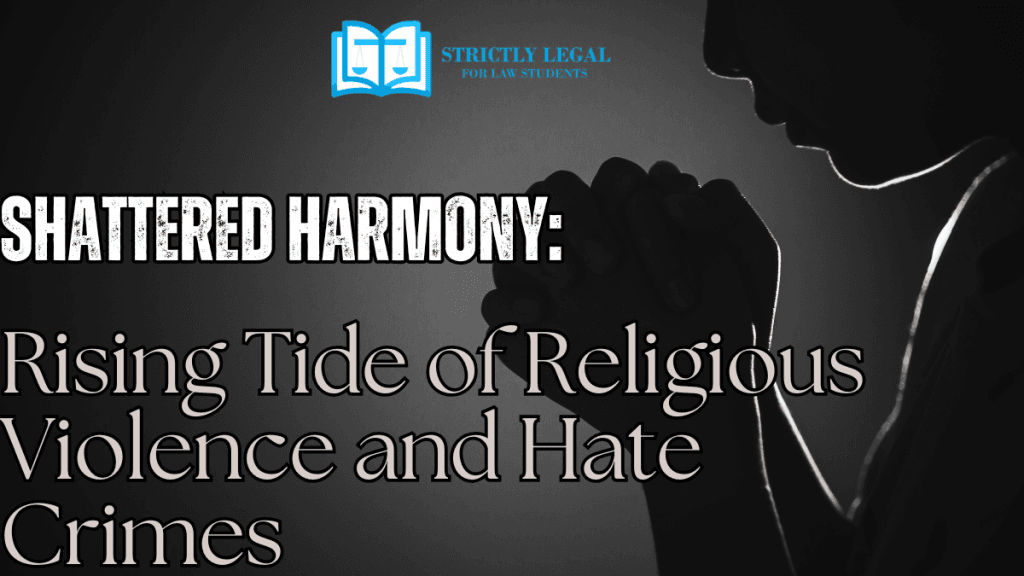India, a land of diverse cultures, religions, and traditions, has long been celebrated for its pluralistic society. However, despite its rich heritage of tolerance, the nation has grappled with incidents of religious violence and hate crimes. These events have not only caused immense harm to individuals and communities but have also posed significant challenges to the fabric of Indian democracy and social harmony. The problem of violence against Muslims in India stems from political ideology and historical tensions. This violence can take many different forms, such as unplanned attacks, targeted attacks, and communal riots. Unresolved geographical issues and historical factors originating from the 1947 Partition of British India have led to the ongoing hostilities.With policies and language that marginalize Muslims and advance a Hindu majoritarian goal, Hindu nationalism—which is promoted by organizations like the Bharatiya Janata Party (BJP)—has made religious divides worse. Social insecurity is exacerbated by the legal and law enforcement authorities’ inability to handle violence against Muslims. As a result, Muslims in India experience property destruction, death and injury, and social and economic marginalization. Thus, taking thorough steps to combat political and religious ideas is one of the finest strategies. In order to foster understanding amongst various communities, initiatives like peace education programs are crucial.
Table of Contents
Understanding the Concept
Religious violence refers to physical harm, destruction, or threat directed at individuals or groups based on their religious beliefs or affiliations. It may occur as communal riots, targeted attacks, or violent protests between different religious communities. Hate crimes, more broadly, include criminal acts motivated by prejudice, bias, or hatred toward an individual or group based on their religion, race, ethnicity, or other characteristics. In the context of India, hate crimes frequently manifest as violence against minority communities, particularly against Muslims, Dalits, Christians, and other religious minorities.
Beginning of the impropriety
Religious violence has been a recurring problem in India’s history, from the pre-independence era to the present day. Some of the well-known notable ones can be given below.
Partition Violence (1947): The widespread and violent sectarian violence that followed British India’s August 14 and 15, 1947, division into India and Pakistan is known as the Partition Violence of 1947. The partition was a result of religious and political differences, with the Indian National Congress and the All-India Muslim League pushing for separate states based on religious identity—Hindus and Sikhs in India, and Muslims in Pakistan. The partition was accompanied by one of the largest mass migrations in human history.
Anti-Sikh Riots (1984): Often referred to as the “1984 Sikh Massacre”, were a series of violent attacks on Sikhs and their properties across India, particularly in Delhi, following the assassination of Prime Minister Indira Gandhi on October 31, 1984. She was killed by her Sikh bodyguards, which led to widespread anti-Sikh sentiments and violent reprisals across the country. Thousands of Sikhs were killed, and countless others were injured or displaced. The attackers, often organized mobs, looted properties, set fire to homes and gurdwaras, and brutally assaulted and murdered Sikhs, many of them with particular hatred due to their distinct appearance, which includes turbans and beards. The violence was marked by extreme brutality and the active involvement or indifference of police and political leaders. Many eyewitnesses reported that police forces either stood by or directly participated in the violence. In the aftermath, the government response was criticized for being inadequate and for failing to hold the perpetrators accountable
Gujarat Riots (2002): The Gujarat riots or popularly known as “The Gujarat Massacre” were triggered by the burning of a train carrying Hindu pilgrims, leading to violent clashes between Hindu and Muslim communities. Hundreds of Muslims were killed, and many more were injured or displaced in what was widely criticized as a state-sponsored atrocity. At least 1,000 people were killed as anti-Muslim violence swept through the Indian state of Gujarat in 2002. Muslims made up the majority of the victims. Shri Narendra Modi ji a lifelong member of the Hindu fundamentalist RSS, served as Gujarat’s then Chief Minister. The cause of the fire to the train cars is still unknown and long lost in the pages of the history, however, what is known is the conflict between two religions i.e. the Hindus and the Muslims.
Muzaffarnagar Riots (2013): Religious violence broke out in Uttar Pradesh’s Muzaffarnagar district, resulting in the deaths of dozens, primarily from the Muslim community, as well as widespread displacement and destruction The Hindu-Muslim confrontations that broke out in the Indian town of Muzaffarnagar on September 7 resulted in the deaths of about fifty persons. It has been said that these riots are the worst to hit India in ten years. Due to the violence, tens of thousands of people had to leave their houses.
Kashmir Conflicts: The Kashmir conflict, marked by territorial disputes between India and Pakistan, has been a significant source of communal tension and violence, contributing to hate crimes in the region. Over decades, the conflict has fueled religious and ethnic animosities, especially between Muslims in Jammu and Kashmir and the Indian state, which is predominantly Hindu. Militancy, cross-border terrorism, and insurgency, often fueled by extremist ideologies, have led to widespread violence, including targeted killings, forced displacement, and human rights abuses. The revocation of Jammu and Kashmir’s special status in 2019 further escalated tensions, sparking protests, crackdowns, and accusations of systemic repression against the Muslim-majority population. The conflict continues to foster an environment of mistrust and hatred, with civilians on both sides suffering from the long-standing animosities and ideological divides.
Reason behind Hate Crimes in India
Political exploitation: In order to win votes, politicians occasionally take advantage of religious feelings, which sows discord and enmity among communities. Religious divisiveness turns into a powerful political tool that frequently results in bloodshed during religious gatherings or elections.
Religious Nationalism: Hate crimes have occasionally increased as a result of the rise of religious nationalism, especially Hindu nationalism (linked to organizations like the Rashtriya Swayamsevak Sangh, or RSS, and political parties like the Bharatiya Janata Party, or BJP). Some of these groups’ rhetoric has the potential to sow discord and animosity within religious communities.
The Caste System: Despite efforts to eradicate caste-based discrimination, the caste system remains deeply entrenched in Indian society. Lower-caste (Scheduled Castes, Scheduled Tribes, and Other Backward Classes) individuals continue to face discrimination and violence at the hands of upper-caste groups. Dalits, in particular, are often the victims of hate crimes, including caste-based violence, discrimination, and sexual violence.
Honor-based Violence: Caste-based “honor” has a big influence on how people interact with one another in some rural communities. Crimes like “honor killings,” which are carried out in the name of upholding caste or family honor, nevertheless happen.
Regionalism and Ethnic Identity: Tensions between various ethnic and linguistic groups often lead to hate crimes, particularly in states with diverse populations. Regional identity movements, such as those in the North-East, Tamil Nadu, and Maharashtra, have at times escalated into violence against migrants or “outsiders.”
Immigration and Resource Competition: Conflicts between local populations and migrants from other regions or countries (e.g., Bangladeshis in Assam, or Nepali migrants in the North-East) often result in hate crimes, fueled by competition for resources, jobs, and political power.
Social Media and Fake News: The spread of fake news, misinformation, and hate speech via social media platforms like WhatsApp, Facebook, and Twitter can quickly escalate tensions, leading to mob violence and hate crimes. Incidents like cow slaughter rumors or “love jihad” theories have triggered widespread violence.
Deeply Held Prejudices: A lot of Indian communities have long-standing biases against one another, frequently stemming from religious customs, cultural distinctions, or old grievances. When societal tensions or tragedies deepen preexisting divides, these biases can result in hate crimes.
Identity Politics: Identity-based politics, where leaders focus on protecting the interests of specific groups, can also contribute to resentment between different communities. This often results in the marginalization of other groups, which can escalate into hate crimes.
Is “Love Jihaad” a type of Hate Crime?
“Love Jihad” is a controversial and unproven conspiracy theory that claims Muslim men in India are deliberately attempting to convert Hindu women to Islam by courting them under the guise of romantic relationships or marriages. The theory suggests that Muslim men are using love as a means to infiltrate Hindu families, convert women, and ultimately increase the Muslim population. The term “Love Jihad” gained popularity through certain media outlets, political groups, and extremist organizations, but there is no credible evidence supporting its existence.
The core premise of the “Love Jihad” theory is that Muslim men are using romance as a tool to manipulate and convert Hindu women. Some proponents of the theory argue that this is part of a larger, coordinated attempt by Muslims to undermine Hindu society and culture. This narrative often portrays interfaith relationships, particularly between Hindu women and Muslim men, as part of a supposed conspiracy to weaken the Hindu community, a perspective that feeds into communal divisions and religious intolerance.
The “Love Jihad” theory first gained attention in 2009 when it was raised by some right-wing political leaders and groups in India, particularly in Uttar Pradesh, Kerala, and Maharashtra. These groups alleged that Muslim men were specifically targeting Hindu women for conversion through marriage. Some individuals and groups promoting the “Love Jihad” theory claim that there are organized efforts by Muslims to target Hindu women through fake identities or promises of marriage, intending to eventually convert them to Islam. These claims, however, lack empirical support and are widely discredited by experts and secular organizations. In some cases, claims of “Love Jihad” have been used to justify violence against couples in interfaith relationships or to impose social pressure on families and communities to oppose such unions.
Legal Frameworks for Hate Crimes in India
n India, hate crimes are not explicitly defined under a single piece of legislation, but various laws address aspects of hate speech, communal violence, and acts of discrimination that could be categorized as hate crimes.
The Religious Institutions (Prevention of Misuse) Act, 1988: This law aims to prevent the misuse of religious institutions for promoting hatred or violence. It addresses issues like the unlawful propagation of religious enmity, especially in relation to religious places of worship.
The Unlawful Activities (Prevention) Act (UAPA), 1967: UAPA is a comprehensive law that deals with the prevention of unlawful activities, including terrorism and violence. Although not specific to hate crimes, the law is often used to prosecute individuals or groups engaged in activities that promote religious or communal violence, including those linked to extremist organizations that incite hatred or violence against particular communities.
The National Commission for Minorities Act, 1992: This Act establishes the National Commission for Minorities, which acts to safeguard the rights and welfare of religious minorities in India. It can recommend measures for preventing hate crimes and violence against minorities and suggest legal or policy reforms.
Constitution of India:
- Article 15: Prohibits discrimination on the grounds of religion, race, caste, sex, or place of birth. This is a crucial provision for addressing hate crimes related to caste, religion, or ethnicity.
- Article 25-28 (Freedom of Religion): These articles guarantee individuals the right to freely practice and propagate their religion, while also limiting practices that harm social harmony or incite hatred against other religions.
- Article 29-30 (Cultural and Educational Rights): These articles protect the rights of minorities and help prevent their cultural and educational marginalization, indirectly safeguarding them against hate crimes related to religious and ethnic backgrounds.
Indian Penal Code: (Now BNS)
- Section 153A (Promoting Enmity Between Different Groups): This section criminalizes acts that promote hatred, contempt, or enmity between different religious, racial, or linguistic groups. Anyone found guilty of promoting such sentiments can be punished with imprisonment and fines.
- Section 295A (Deliberate and Malicious Acts Intended to Hurt Religious Feelings): This section deals with actions intended to outrage religious sentiments or provoke religious enmity. It is often invoked in cases involving offensive statements or acts against religious communities.
- Section 298 (Uttering Words with Intent to Hurt Religious Feelings): This section criminalizes speech or actions that are intended to insult or provoke others’ religious feelings. It is relevant in cases where hate speech targets religious beliefs.
- Section 307 (Attempt to Murder): In cases where hate-related violence escalates to serious physical harm or murder attempts, this section can be invoked.
- Section 499 (Defamation): In cases of hate speech that harms the reputation of individuals or groups, this section may be used for criminal defamation.
Conclusion
hate speech in India remains a significant challenge that threatens social harmony, national unity, and the values enshrined in the Constitution. While there are legal provisions to address hate speech, including sections of the Indian Penal Code and constitutional safeguards against discrimination, the lack of a comprehensive and clear-cut law specifically targeting hate speech complicates the issue. Despite the legal framework, the enforcement of these laws is often inconsistent, and political, religious, and social factors can influence how cases of hate speech are handled. The rise of social media and digital platforms has further exacerbated the problem, with hate speech spreading rapidly and fueling communal tensions.

Law student.
Turning legal insights into engaging narratives.





